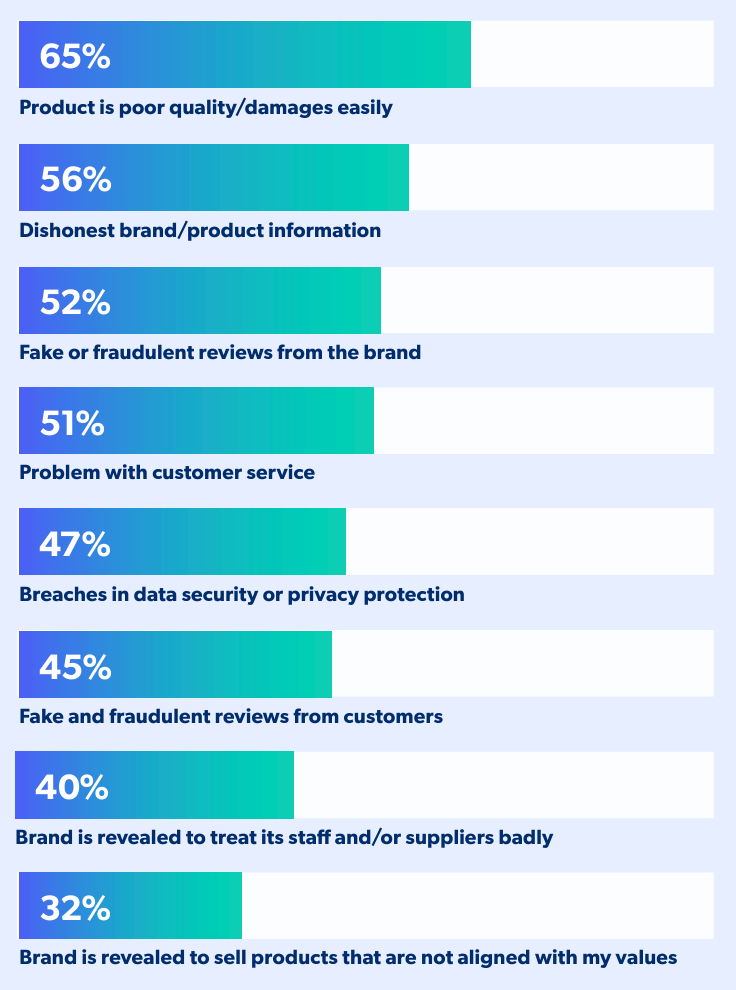October 13, 2023
In today’s retail landscape, brand trust is one of the most valuable assets a business can have. About 82% of shoppers won’t buy from a brand they don’t trust, and 62% of shoppers choose products based on a brand’s reputation, according to research. Building brand trust with consumers is step one to getting on their good sides.
What is brand trust?
Brand trust is the amount of loyalty and support customers have for your brand and how strongly they believe you can fulfil your brand promises. It’s based on customer experiences with your brand as well as company messaging and reputation.
Brands and retailers who can’t establish trust with consumers, or even worse, who lose established trust, will struggle to win business. We’re in an age when consumer opinions are shared on a massive scale and directly influence brand perception.
In a Bazaarvoice study, 54% of consumers said that if a brand hasn’t broken trust, they’d still buy from them again — even after a negative experience.
5 ways to build brand trust
It’s simple. When your customers trust you, they’ll be loyal to you almost no matter what. Here’s how to build consumer trust in your brand.
1. Work with a trustworthy UGC provider
One way to increase brand trust in e-commerce is by getting your consumers to advocate for your brand for you. Shoppers trust user-generated content (UGC) in the form of reviews more than they trust family and friend recommendations. Instead of trying to control what people are saying, brands and retailers should embrace this conversation and amplify it.
However, to maintain brand trust, reviews must be authentic. According to our survey of 10,000 global shoppers, if shoppers suspect a product has fake reviews:
- 81% will avoid using that brand again
- 48% leave a negative review
- 25% wouldn’t purchase from the website
- 16% will post negatively about the brand on social media
That’s why a good UGC program requires strong content moderation. A trustworthy UGC provider that values authenticity can help your brand sort through reviews and eliminate fake ones that hurt your credibility and destroy consumer trust.
For example, Bazaarvoice evaluates UGC through a process of machine learning and human moderation to ensure it isn’t fraudulent and that it represents a customer’s genuine opinion about their experience with the product(s).
27% of consumers think brands with fake content should be fined up to 30% of their revenue — and governments are taking note. The FTC recently fined one company over $4 million for suppressing authentic content, so not only will fake content harm your reputation but it will harm your wallet too.
2. Publicize company values
According to Edelman’s Trust Barometer, consumers today grant brand trust based on two attributes: competence and ethical behavior. Like doing the right thing and working to improve society.
Consumers want to see what your brand believes in and how you follow through on those beliefs. And with the various significant events taking place across the globe, they especially want to know how your brand responds to your community in times of crisis. This is particularly true when it comes to Gen Z, who value brand trust, transparency, and authenticity above all else.
Creating content about your values for your website is a good start, but make sure this messaging is also visible on your social channels. About 35% of consumers look to a brand’s social media to seek out content about company response and values.
You also need to be mindful of who your brand partners with. Any influencers or partners you collaborate with should share your brand values and have a solid reputation. They’ll connect with consumers in ways that are relevant and sensitive to their needs and help authentically communicate your brand’s values.
3. Focus on great customer service
90% of consumers say a brand’s level of customer service is an important factor in their choice to become a customer. A proactive customer service strategy should include responding to customer feedback and reviews, both negative and positive.
Around 60% of consumers say that negative reviews are just as important as positive reviews in their decision to purchase. And the way you respond to these negative reviews can speak volumes about your brand’s values and may even convert more browsers into buyers. A consumer’s willingness to purchase a product with a negative review doubles when seeing a brand’s response, as opposed to seeing the negative review by itself. And, up to 70% of dissatisfied customers will do business with a company again if their complaint is resolved.
When you see a negative review, take the time to craft a quick, but personal, response. Consumers want to talk to a real person, not a review response bot. Show them that you sympathize with their issue and that you’re learning from criticism. Mention that their feedback will be used for future improvements. This will only boost your brand trust.
In your online response, ask the customer to contact you offline. And be clear about why. Are you trying to understand the problem because your team is working on product improvements? Are you looking for details on the issue so you can prevent it from happening again? Was there a defect, and you need their contact information to send the new product?
Don’t forget to give the customer a way to contact your brand, whether that’s via a preferred phone number or email address.
4. Create high-quality products
Reviews are excellent sources of information to analyze how consumers feel about your products’ quality. When you pay attention to common customer pain points, you have the opportunity to fix issues before your products earn a negative reputation and win back customers before you lose them entirely.
Look for key topics in your negative reviews. Do customers complain about particular product features? Long shipping times or damaged delivery? Is there something missing that they wanted from the product? Was the product description inaccurate?
Share this customer sentiment with your product quality or manufacturing team (or with vendors if you’re a retailer) to make improvements that keep your products competitive and meet consumer expectations.
5. Price your products fairly
According to Prisnyc, a competitor price tracking and monitoring company, about 60% of consumers consider pricing as the very first criteria of their buying decision, and 86% say it’s important to compare prices from different sellers when shopping.
When’s the last time you compared your product price to the competition? If it’s been a while, it’s time to re-evaluate. How do your prices differ from competitors?
Consumers value transparency. If your product is significantly more expensive than the competition and there’s a reason for it (like you use a higher quality material), don’t be afraid to call that out on your product pages.
Build brand trust with the voice of the customer
To protect consumer trust, your brand must prioritize honesty and transparency in everything you do, from reviews to customer service to product pricing. One of the best ways to gain insights into how customers feel about your brand and communicate trust is through ratings and reviews.
Leverage the authentic voice of your customers to build brand trust and sell your products. Taking the time to invest in your ratings and reviews program will help you build the foundation for long-lasting relationships and brand trust with your customers, leading to more sales — after all, customers who interact with UGC are 2x as likely to convert.











